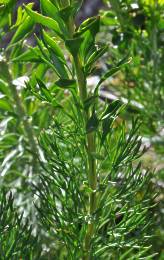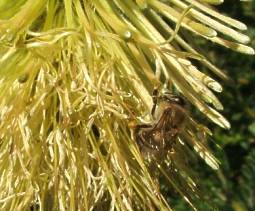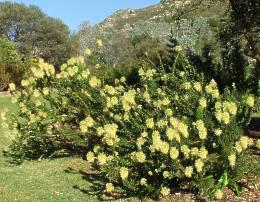Paranomus reflexus
Paranomus reflexus (E.Phillips & Hutch.) Fourc.
Family: Proteaceae
Common names: Van Staden's sceptre
Introduction
Paranomus reflexus is an unusual, decorative fynbos shrub with showy winter flowers; it is probably the best known paranomus but is not often seen in gardens, yet is as deserving of a place as its relatives, the pincushions and proteas.

Description
Description
Paranomus reflexus is a robust, well-branched shrub, 1-2 m tall. It has leaves of two different kinds: low down on the stem they are dissected while on the upper part of the stem, particularly on stems carrying flowerheads, they are entire. The dissected leaves are 40-80 mm long, hairless, with slender segments divided in the upper half and tipped with red.
The entire leaves are 35 mm long, egg- to spatula- shaped, hairless and reduce in size towards the tip of the stem. The petiole is up to 15 mm long and clasps the stem. The leaf blade turns outwards and the edges curve upwards.

Elegant cream to greenish yellow flowerheads cover the bush during winter-spring (Jun.-Aug.). The flowerheads are 80-140 mm long and up to 70 mm in diameter and resemble a bottlebrush. The flowerhead is made up of many individual flowers, each one 30-35 mm long, very slender, and possessing four free perianth segments. Just before the flowers open they turn downwards (reflex). As soon as they have reflexed, the perianth segments separate, releasing the style with its pollen presenter.
The perianth segments can be seen as the mass of curled threads on the lower half of the flowerhead. The pollen presenter is the 5 mm long green tip of the style. The stigma is a tiny groove at the tip of the style. The seeds are released about two months after flowering. The seed, more correctly termed the fruit, is a smooth achene with a ring of hairs around the base.

Although Paranomus species are quite tricky to differentiate, this one is easy to recognise as no other species produces a similar flowerhead. The closest is P. sceptrum-gustavianus, King Gustav's sceptre, which has similar leaves but its flowerheads are smaller and the flowers are shorter and do not bend downwards, and the two species are separated geographically.
Conservation Status
Status
Endangered. Paranomus reflexus occurs over an area of 605 km², occupies only 34 km², and has severely fragmented populations. This species is continuing to decline because its habitat is being destroyed by timber plantations, and invasion by alien plants.
Distribution and habitat
Distribution description
Paranomus reflexus grows on sandstone slopes, at an altitude of 1000-2000 m in the Van Stadens Mountains and the Elandsberg, near Port Elizabeth in the Eastern Cape. It is confined to Kouga Sandstone Fynbos, and occurs in small clumps of a few dozen plants scattered through its range. Climate in this region is warm temperate and rainfall is low and falls throughout the year. This species is the most easterly member of the genus.
Derivation of name and historical aspects
History
The genus Paranomus gets its name from its unusual leaves. It means illegal, or contrary to custom, from the Greek para meaning beyond or contrary to, and nomos custom or law, referring to the leaves that are different from the normal pattern or out of the ordinary.
The species name reflexus means reflexed from the Latin reflecto, to bend back, turn back or turn round, and refers to the way the flowers bend downwards as they open. This genus also records the infamous clash between the botanists Salisbury and Brown. Brown's name for this genus was Nivenia to honour the plant collector James Niven, but Salisbury published before Brown, so his name Paranomus is the one that is valid and in use today.
A sceptre is a symbolic ornamental staff held by a sovereign or ruling monarch or worn as a badge or emblem of authority. It is a staff topped with various ornaments depending on the country and period, e.g. a globe, a bird, a lily, or a cross. Paranomus species have earned their common name because their flowerheads resemble a sceptre. The first one to be given this name was Paranomus sceptrum-gustavianus, King Gustav's sceptre. Sparrman found it and named it in 1777, and the common name was later extended to all members of the genus.
The genus Paranomus belongs in the Protea Family (Proteaceae). It is a small genus of 18 species that occur mainly in the mountains of the Western and Eastern Cape from the Cederberg to Uitenhage, with the highest concentration of species in the districts of Caledon, Worcester and Swellendam. They are easily recognised by their leaves which vary from dissected to entire, and many species have both at the same time. This is not the only unusual feature of the leaves; they are also strange in that they don't have a distinct upper and lower surface and don't lie flat like most leaves. They also have a very primitive system of veins. In most modern plants leaves have a midrib from which the minor veins arise. In Paranomus the veins fork repeatedly and don't meet up or unite. This type of venation is characteristic of primitive vascular plants. The dissected leaves have a groove on the upper surface and end in a smooth, shiny, often translucent point, and are always slightly curved upwards. Flowerheads are spike-like made up of many individual flowers. The flowers are grouped into fours, each group of four carried underneath a single leathery bract. These bracts stay on the plant for a year or more, becoming like tiny wooden shells and remaining long after the seeds have dropped off.

Ecology
Ecology
Paranomus reflexus flowers are pollinated by insects, and are well visited by bees at Kirstenbosch.
Plants are killed by fire and do not resprout but after a fire seedlings usually appear in large numbers. The seeds drop from the flowerheads about two months after flowering and are carried off by ants to their nests where the elaiosome (a layer or growth on the seed that is attractive to ants and usually contains nutrients for them) is consumed. The rest of the seed remains uneaten and unharmed underground, safe from predators like mice, and fire. This method of dispersal is known as myrmecochory.
Uses
Use
Paranomus reflexus makes an interesting and decorative garden shrub and is a good cutflower with a long vase life.
Growing Paranomus reflexus
Grow
Paranomus reflexus so far, is the only Paranomus that survives and thrives in general cultivation in the garden at Kirstenbosch. It is fast growing and easy to cultivate, but requires well-drained, acid sandy soils, free air circulation and a sunny position to do well. It tolerates drought but performs best with moderate water all year round.
Like most other proteas it is a light feeder with a sensitive root system that is adapted to very nutrient-poor soils. It will not tolerate strong fertilisers and manures, but should be fed with well-rotted compost and, if using chemical fertilisers, choose a slow release or apply very low doses. Proteas don't like phosphates (P), so choose a fertiliser that has little or no P in its formula.
Like many fynbos species it is relatively short-lived, needing replacement after 8-15 years. Paranomus reflexus is susceptible to infection by the phytophthora root rot fungus, so care should be taken to keep root disturbance to a minimum; avoid breaking them by not digging around their base inside their drip-line, rather put down a thick layer of mulch once or twice a year and leave them undisturbed.

Grow Paranomus reflexus in the fynbos garden, water-wise garden, Mediterranean garden, on a sunny slope, in a shrubbery or rockery.
Paranomus reflexus is easily propagated by seeds or cuttings. Sow in late summer-autumn in sterile, well-drained soil. Press the seeds into the surface and cover with clean sand or fine-milled bark and keep moist but not wet. Transplant into individual containers filled with well-drained, acidic soil mix as soon as the first pair of true leaves has developed.
Take semi-hardwood cuttings in autumn or spring. Do not take cuttings from stems with flower buds, we have found that cuttings from the stems with dissected leaves root better than those from stems with the single leaves. Remove the leaves from the basal third of the cutting, treat with a rooting hormone, and place in a well-drained rooting medium under intermittent mist with bottom heat of 24°C.
References
- Jackson, W.P.U. 1990. Origins and meanings of names of South African plant genera. U.C.T. Printing Dept., Cape Town.
- Leistner, O.A. (ed.). 2000. Seed plants of southern Africa: families and genera. Strelitzia 10. National Botanical Institute, Pretoria.
- Levyns, M. 1970. A revision of the genus Paranomus (Proteaceae). Contributions of the Bolus Herbarium 2.
- Plants of southern Africa: an online checklist. http://posa.sanbi.org
- Protea Atlas Project. http://protea.worldonline.co.za
- Raimondo, D., Von Staden, L., Victor, J.E., Helme, N.A., Turner, R.C., Kamundi, D.A. & Manyama, P.A. (eds) 2009. Red List of South African plants 2009. Strelitzia 25. South African National Biodiversity Institute, Pretoria.
- Rebelo, Tony. 2001. Proteas, A Field Guide to the Proteas of Southern Africa, edn 2. Fernwood Press, Cape Town.
- Vogts, Marie. 1982. South Africa's Proteaceae, Know them and grow them. Struik Publishers, Cape Town.
Credits
Alice Notten
Kirstenbosch National Botanical Garden
June 2010
Plant Attributes:
Plant Type: Shrub
SA Distribution: Eastern Cape
Soil type: Sandy
Flowering season: Spring, Winter
PH: Acid
Flower colour: Green, Yellow
Aspect: Full Sun
Gardening skill: Average
Special Features:
Horticultural zones











Rate this article
Article well written and informative
Rate this plant
Is this an interesting plant?
Login to add your Comment
Back to topNot registered yet? Click here to register.